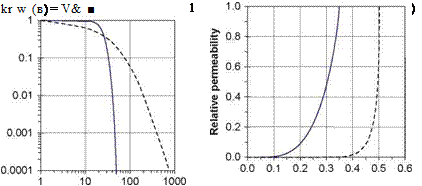Permeability in Unsaturated Soil
Water flow in unsaturated soils is primarily dependent on the volumetric water content, matric suction and on the gravitational potential. Due to the presence of air within part of the pores, water movements are obstructed and flow is only achieved through the finer pores or in films around the soil particles. The permeability (or “hydraulic conductivity”) of unsaturated soils is, therefore, reduced compared with fully saturated soils due to the presence of air in the porous media. Usually the permeability of unsaturated soils is given as the water-relative permeability defined as the ratio of the permeability at a specific water content to its permeability under fully saturated conditions, thus:
K w (в)
krw (в) = – W (2.35)
K
where krw (в) is the water-relative permeability, Kw (в) is the water permeability – both being functions of the volumetric water content, в – while K is the saturated coefficient of permeability. Brooks and Corey (1964,1966) suggested that the water – relative permeability could be estimated as
krw (в) = 0V+ v (2.36)
 |
where X is a the pore size distribution index and & is the normalized water content. Based on Mualem’s model (Mualem, 1976) van Genuchten (1980) expressed the water-relative permeability as:
Suction [cm] Vol. water content
Fig. 2.11 Water-relative permeability for a coarse (unbroken line) and fine grained (dotted line, mostly to the right in each figure) soil using van Genuchten’s equation. The parameters used to plot the curves are given in Table 2.2
where M is the same experimental parameter as given in the van Genuchten’s SWCC.
Figure 2.11 shows clearly that the permeability of a porous medium varies significantly with the suction or the volumetric water content (or degree of saturation as Sr = в/n). A reduction in the degree of saturation from fully saturated soil to 80% results in a relative permeability of only 36% of the saturated permeability for the sand and 18% for the clay respectively in the above figure. Hence, modelling water movements in pavement structures needs to address this to obtain a realistic movement of the water flow.






Leave a reply